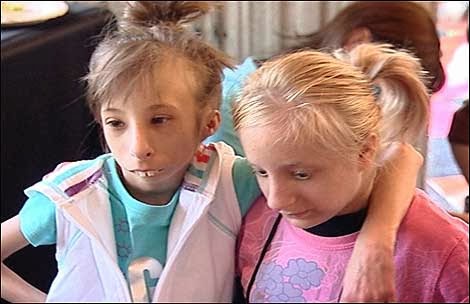PRIMORDIAL DWARFISM
dwarfism

viernes, 3 de enero de 2014
Cases of People with the disease
A story about Kenadie Jourdin Bromley, a four-year-old girl with primordial dwarfism.
Twins only known with a primordial dwarfism
Five-year-old tiny girl Charlotte Garside
Primordial Dwarfism
Introduction
Primary dwarfism, also called Taybi-Linder
syndrome. It is
as rare and severe dwarfism, since individuals who suffer from it have a
setting to the 70 cm height, but maintaining a proportion in your body. It is
estimated that there are only 100 individuals in the world with this disorder,
40 of them in the United States.
History
History
The first documented case that exists about
this disease is the one of Caroline Crachami. She was born in 1815 in Italy
and she was known as the "Sicilian fairy" for her short stature,
which did not exceed 50 cm. Believed that he was born by measuring 20
centimeters and thinking just half a kilo. Dr. Gilligan, stunned by this
strange anomaly, exhibited her in London months before his death, making known
this case of dwarfism. After early death in 1824 her father gave the body to
science, and numerous investigations were conducted, arousing the interest of
many scientists.
Other cases reported are those of the
well-known "princess Pauline", born at the end of the 19th century in
the Netherlands, which, with just 58 cm, traveled around the world dedicated to
the spectacle. She died at age 19 from pneumonia and meningitis. The case of
Lucía Zarate, who was also a victim of this disease and an early death (26
years) recorded in Mexico.
Cause
Medical researchers are still in the dark
about the exact causes of primordial dwarfism. There are two theories. This
disease one associates with a major malformation of the central nervous system,
with a deficiency of hormone pituitary gland (such as GH growth hormone) by
which growth would be paralyzed.
Another hypothesis, and the most accepted,
is that this malformation arises mainly due to genetic factors. It is believed
that it is a hereditary acquired condition that develops when an embryo
receives a copy of the defective gene from each parent. The condition may not
be evident in the parents. However, it might have the defective gene for
recessive form.
A
report published in January, 2008 mentions mutations(changes) in the gene
pericentrin as the cause of essential dwarfism. This gene has a role in
cytokinesis, proper chromosome segregation and cell division.
Symptoms
The symptoms usually become apparent while
the child is in the fetal stage. The belly of a pregnant woman does not grow as
expected although ultrasound tests and other images show a small fetus with
normal growth proportions. The labor pains start early and birth usually occurs
before time, approximately 35 weeks of gestation. After birth, the baby has
very low weight and height (the height normally be 20 centimeters and weight do
not reach the half a kilo). However, all organs of such newly born are in
perfect state of development.
Characteristics
Characteristics
People suffering from this disease, have special features which,
although in its first three years of life are not significant, so are
subsequently. Some of them are:
- Low weight and height at birth: between 20 centimeters in height and 800 grams.
- Microcephaly. The size of the head is proportional to body size at birth. However, as children grow and develop, the head grows slower than the body and becomes small and disproportionate in relation to the rest of the body, taking early triangular shape.
- Prominent nose and eyes. The shape of the nose may be evident at birth or may develop during the first year.
- Small teeth with poor enamel and the spaces between them increased.
- Trunk, chest and spine: scoliosis Arms and legs: defective joints, showing movements in its structure.
- The tone of voice is very sharp.
Life expectancy
The life expectancy of people with this disease is approximately 30 years. The low life expectancy of these people is due to the fact that they are often accompanied by medical complications like vascular disorders.
Treatment
Unfortunately there is no healing method to reverse the changes caused by this disease. This is mainly due to the lack of knowledge about the cause of the disease. The administration of growth hormone does not have any effect on the patient, so that it supports the hypothesis of genetic inheritance in this disease.
The life expectancy of people with this disease is approximately 30 years. The low life expectancy of these people is due to the fact that they are often accompanied by medical complications like vascular disorders.
Treatment
Unfortunately there is no healing method to reverse the changes caused by this disease. This is mainly due to the lack of knowledge about the cause of the disease. The administration of growth hormone does not have any effect on the patient, so that it supports the hypothesis of genetic inheritance in this disease.
Suscribirse a:
Entradas (Atom)




